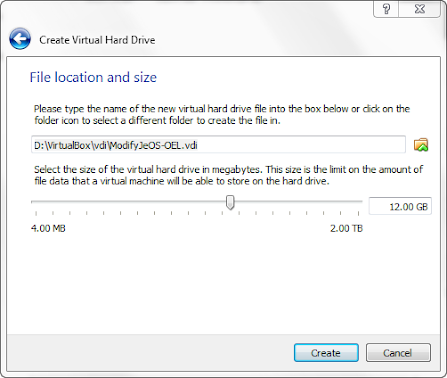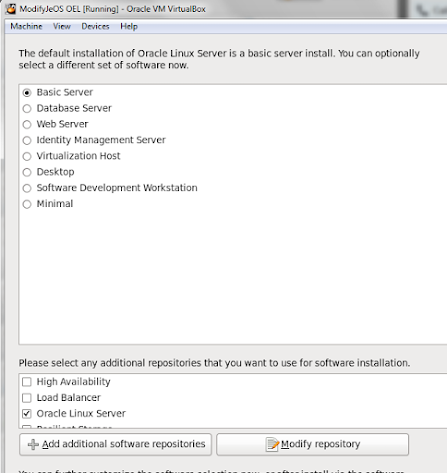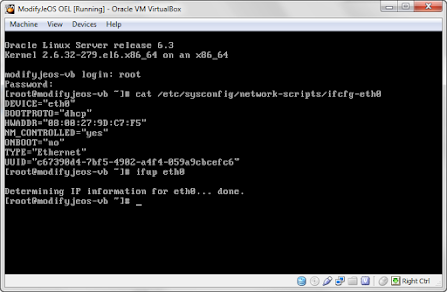Exalogic 2.0.1 Tea Break Snippets - Creating a ModifyJeOS VirtualBox
Posted
by The Old Toxophilist
on Oracle Blogs
See other posts from Oracle Blogs
or by The Old Toxophilist
Published on Thu, 6 Dec 2012 15:58:37 +0000
Indexed on
2012/12/06
17:12 UTC
Read the original article
Hit count: 438
/A-Team
Following on from my previous blog entry "Modifying the Base Template" I decided to put together a quick blog to
show how to create a small VirtualBox, guest, that can be used to
execute the ModifyJeOS and hence edit you templates. One of the
main advantages of this is that Templates can be created away from
the Exalogic Environment. For the Guest OS I chose OEL 6u3 and
decided to create it as a basic server because I did not require a
graphical interface but it's a simple change to create it with a
GUI.
Required Software
Creating the VM
I'll assume that the reader is experienced with Virtual Box and
installing OEL and hence will make this section brief.
Create VirtualBox Guest
Create a new VirtualBox Guest and select oracle Linux 64 bit. Follow through the create process and select Dynamic Disk Size and the default 12GB disk size. The actual image will be a lot smaller than this but the OEL install will fail with insufficient disk space if you attempt a smaller size.

Once the guest has been created attach the previously downloaded
OEL 6u3 iso to the cd drive and start the guest.
Install OEL
On starting the guest the system will boot off the associated OEL
6u3 iso and take you through the standard installation process.
Select all the appropriate information but when you reach the
installation type select Basic Server because we do not need that
additional packages and only need to access through the command
line interface.

Complete the installation and reboot the Guest. At this point we
now have a basic OEL server running.
Installing Guest Add-ons
Before we can easily access the Guest we will need to add the
VirtualBox guest add-ons. These will provide better keyboard and
mouse integration and allow access the shared folders on the host
machine. Before we can do this we will need to do the following:
- Enable Networking.
- Install additional rpms.
To enable the networking (eth0), that appears to be disabled by
default, we can execute:
ifup eth0

This will start the eth0 connection but once the Guest is
rebooted the network will be down again. To resolve this you will
need to edit the /etc/sysconfig/network-scripts/ifcfg-eth0 file
and change the ONBOOT parameter to "yes".
Now we have enabled the network we will need to install a number
of addition rpm. First we will need to configure the yum
repository as follows:
[ol6_latest] name=Oracle Linux $releasever Latest ($basearch) baseurl=http://public-yum.oracle.com/repo/OracleLinux/OL6/latest/$basearch/ gpgkey=http://public-yum.oracle.com/RPM-GPG-KEY-oracle-ol6 gpgcheck=1 enabled=1 [ol6_ga_base] name=Oracle Linux $releasever GA installation media copy ($basearch) baseurl=http://public-yum.oracle.com/repo/OracleLinux/OL6/0/base/$basearch/ gpgkey=http://public-yum.oracle.com/RPM-GPG-KEY-oracle-ol6 gpgcheck=1 enabled=0 [ol6_u1_base] name=Oracle Linux $releasever Update 1 installation media copy ($basearch) baseurl=http://public-yum.oracle.com/repo/OracleLinux/OL6/1/base/$basearch/ gpgkey=http://public-yum.oracle.com/RPM-GPG-KEY-oracle-ol6 gpgcheck=1 enabled=0 [ol6_u2_base] name=Oracle Linux $releasever Update 2 installation media copy ($basearch) baseurl=http://public-yum.oracle.com/repo/OracleLinux/OL6/2/base/$basearch/ gpgkey=http://public-yum.oracle.com/RPM-GPG-KEY-oracle-ol6 gpgcheck=1 enabled=0 [ol6_u3_base] name=Oracle Linux $releasever Update 3 installation media copy ($basearch) baseurl=http://public-yum.oracle.com/repo/OracleLinux/OL6/3/base/$basearch/ gpgkey=http://public-yum.oracle.com/RPM-GPG-KEY-oracle-ol6 gpgcheck=1 enabled=0 [ol6_UEK_latest] name=Latest Unbreakable Enterprise Kernel for Oracle Linux $releasever ($basearch) baseurl=http://public-yum.oracle.com/repo/OracleLinux/OL6/UEK/latest/$basearch/ gpgkey=http://public-yum.oracle.com/RPM-GPG-KEY-oracle-ol6 gpgcheck=1 enabled=1 [ol6_UEK_base] name=Unbreakable Enterprise Kernel for Oracle Linux $releasever ($basearch) baseurl=http://public-yum.oracle.com/repo/OracleLinux/OL6/UEK/base/$basearch/ gpgkey=http://public-yum.oracle.com/RPM-GPG-KEY-oracle-ol6 gpgcheck=1 enabled=0
Once the repository has been edited we will need to execute the following yum commands:
yum update yum install gcc yum install kernel-uek-devel yum install kernel-devel yum install createrepo
At this point we now have all the additional packages required to install the VirtualBox Guest Add-ons. So select Devices->InstallGuest Additions on you running guest:

This will simply place the VirtualBoxGuestAdditions.iso in the virtual cd and we will need to execute the following before we can run them.
mkdir /media/cdrom mount -t iso9660 -o ro /dev/cdrom /media/cdrom cd /media/cdrom/ ls ./VBoxLinuxAdditions.run

This will initiate the install and kernel rebuild. What you will notice is that during the installation a Failed will be displayed but this is simply because we have no graphical components.

At this point we the installation will also have added the vboxsf group to the system and to access any shared folders we will create our user will need to be a member of this group an so the next stage is to add the root user to this group as follows:
usermod -G vboxsf root cat /etc/group cat /etc/passwd init 0
Now simply shutdown the guest and add the Shared folder within
your guests settings.
Install ModifyJeOS
Once the shared folder has been added restart the guest and change directory into the shared folder (/media/sf_<folder name>). For the next step I am assuming the ModifyJeOS rpms are located in the shared folder. We can simply execute:
rpm -ivh ovm-modify-jeos-1.1.0-17.el5.noarch.rpm # Test with modifyjeos

Using ModifyJeOS
I have a modified MountSystemImg.sh script that should be copied
into the /root/bin directory (you may need to create this) and
from here it can be executed from any location:
MountSystemImg.sh
#!/bin/sh # The script assumes it's being run from the directory containing the System.img # Export for later i.e. during unmount export LOOP=`losetup -f` export SYSTEMIMG=/mnt/elsystem export TEMPLATEDIR=`pwd` # Make Temp Mount Directory mkdir -p $SYSTEMIMG # Create Loop for the System Image losetup $LOOP System.img kpartx -a $LOOP mount /dev/mapper/`basename $LOOP`p2 $SYSTEMIMG #Change Dir into mounted Image cd $SYSTEMIMG echo "######################################################################" echo "### ###" echo "### Starting Bash shell for editing. When completed log out to ###" echo "### Unmount the System.img file. ###" echo "### ###" echo "######################################################################" echo bash cd ~ cd $TEMPLATEDIR umount $SYSTEMIMG kpartx -d $LOOP losetup -d $LOOP rm -rf $SYSTEMIMG
This script will simple create a mount directory, mount the
System.img and then start a new shell in the mounted directory. On
exiting the shell it will unmount the System.img. It only requires
that you execute the script in the directory containing the
System.img. These can be created under the mounted shared
directory.
In the example below I have extracted the Base template within the shared folder and then renamed it OEL_40GB_ROOT before changing into that directory and executing the script.

© Oracle Blogs or respective owner